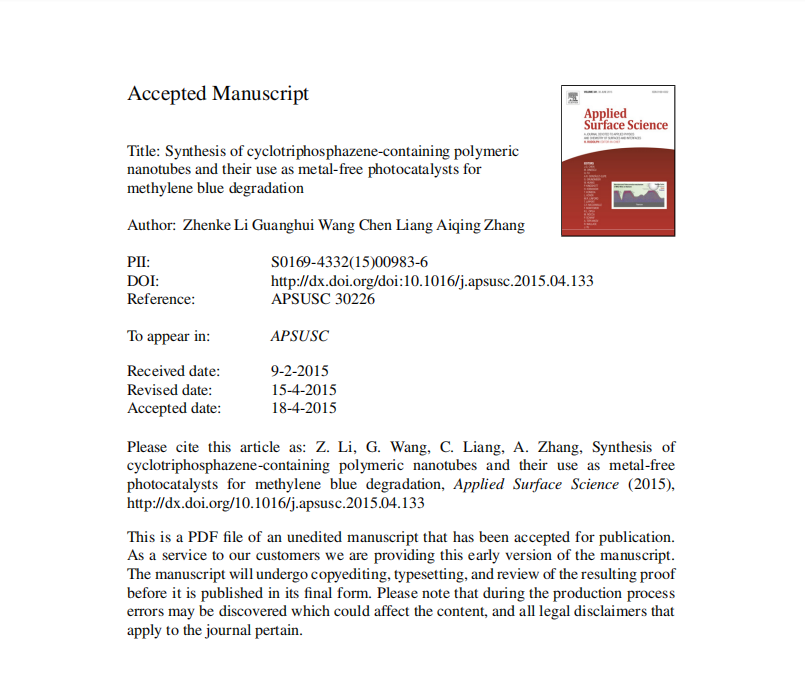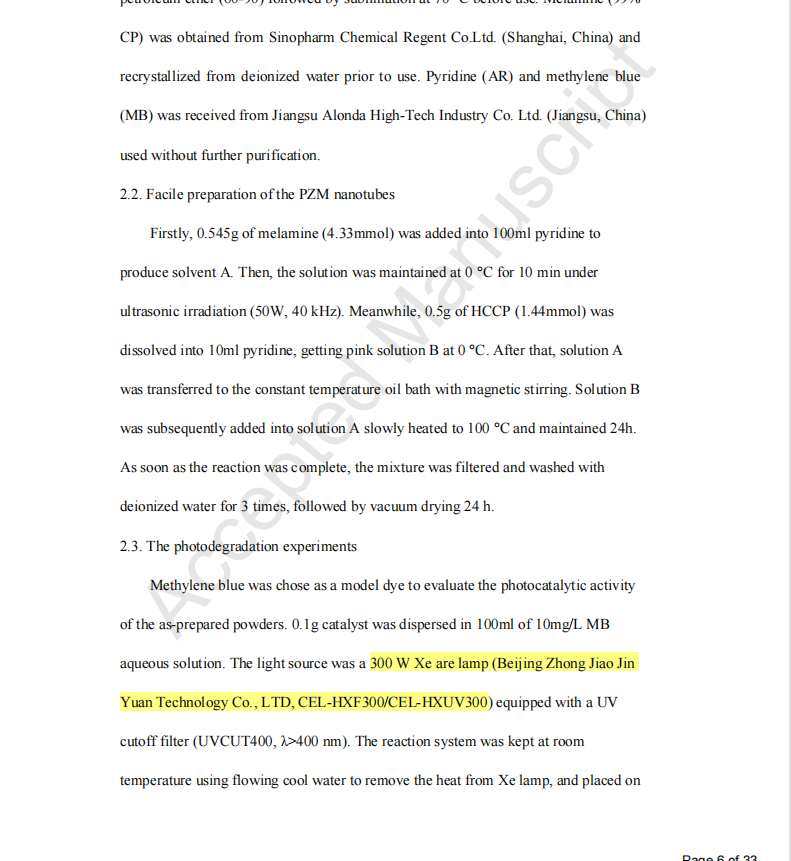Service hotline
+86 18518316054
 Current location : Home page > Resources > Papers > Synthesis of cyclotriphosphazene-containing polymeric nanotubes and their use as metal-free photocatalysts for methylene blue degradation
Current location : Home page > Resources > Papers > Synthesis of cyclotriphosphazene-containing polymeric nanotubes and their use as metal-free photocatalysts for methylene blue degradation
Abstract
Highly cross-linked, organic-inorganic hybrid polymer nanotubes with primary amine groups on the surface have been successfully prepared through a facile polycondensation of hexachlorocyclotriphosphazene and melamine in absence of any surfactants or template agents. Then, these nanotubes were used as visible light photocatalysts for the degradation of methylene blue (MB) in water and the physicochemical properties of catalysts were characterized by several techniques. The as-synthesized nanotubes were closed at one end with a micrometer-scale in length (about 3-10 μm), 200-300 nm in the diameter, and the inner diameters of the two ends of each nanotube was 100-200 nm and 5-10 nm, respectively. A large amount of free radicals (•OH) were generated in aqueous phase under visible light irradiation, which can photocatalytically oxidize and eventually mineralize. And, the progress of degradation was similar with semiconductor materials. The simple preparation method and photocatalytic performance of the cyclotriphosphazene-containing polymeric nanotubes represent an important step towards photocatalytic reaction in general where artificial conjugated polymer semiconductors can be used as energy transducers.
1. Introduction
Effluents, especially dye wastewater, due to its easy adhesion and toxic seriously affects human health. Although many methods based on physicochemical and biological technologies, including adsorption by porous materials [1, 2] and microbial degradation [3], have been devoted to the destruction of dye wastewater prior to their discharge into the receiving water, these systems suffer from incomplete removal of the organics and the formation of byproducts that are even more toxic than the starting materials. Worse of all, some catalysts may be inherently toxic in the way that they function. So, the search for cheap, green and effective catalyst is one of the noble missions of material science. Semiconductor-based photocatalysts for the degradation of dye using solar energy has attracted more and more attentions [4, 5, and 6]. Various transition metal oxide and sulfide, metal-free materials and precious-metal species so for are explored to drive the photocatalytic reaction [7, 8, and 9]. Titanium dioxide (TiO2), which shows relatively high reactivity and chemical stability, has been broadly applied to generate hydroxyl radicals under UV light, giving rise to efficient degration and mineralization of methylene blue in water. It is well known that TiO2 as a kind of star photocatalyst is better than other semiconductors like ZnO and CdS, since they are nontoxic, easy to synthesize and able to degrade most dye. However, the catalytic properties of TiO2 are excavated only under ultraviolet (UV) light [wavelength (λ) < 387 nm] which has been limited them large-scale applied. Considered from this angle, the developing of visible light [wavelength (λ) > 387 nm] excitation of TiO2 should become research focus. One typical route is the doping of a foreign element to reduce the TiO2 band gap, including substitutional doping of C, N, F, P, or S for O and partly substituting for Ti4+ with antimony and chromium in the anatase TiO2 crystals, so that TiO2 can be excited under visible light [10]. Another route is loading noble metal such as Au, Ag, AgCl or Pt on the surface of TiO2, which is attributed to noble metal, could adsorb visible light [11, 12, and 13]. However, whether noble metal loding or foreign element doping can also suffer from drawbacks complex synthesis and multiple fabrication process, and noble metals are both expensive and rare. Graphene-based carbon nitride material shows many intriguing properties such as superior electrical conductivity [14], a large surface area [15], and high thermal/chemical stability [16], which is considered as most promising candidate to complement semiconductor in materials applications. In recent years, metal-free graphitic carbon nitride (g-C3N4) could be obtained through self-condensation of cyanamide, dicyandiamide, ammonium thiocyanate or melamine at high temperature (approximately 600°С) [17]. Different types of g-C3N4 catalysts could generate nanopore structures into the polymeric matrix to improve their structural and electronic functions for solar energy conversion [18]. Cui et al. [19] prepared mesoporous graphitic carbon nitrides by a polymerization of NH4SCN on the surface of silica nanoparticles. The catalysts could be used as visible light photocatalysts for the degradation of organic pollutants in water.
For an excellent photocatalysts, it not only non-toxic and excitation of visible light, but also should be abundant and easily processable into a desired shape. Hexachlorocyclotriphosphazene (HCCP) plays a crucial role in the development of new polymers, due to the excellent tailoring property of the backbone and the unprecedented structural diversity [20, 21]. Recently, morphology-controlled organic-inorganic hybrid polyphosphazene material, including microspheres, nanotubes and nanowires, were prepared by HCCP and 4, 4-sulfonyldiphenol [22], 4, 4-(hexa- fluoroisopylidene) diphenol [23], benzidine [24] or phloroglucinol [25]. However, these special architectures were not suited for dye degradation because these polyphosphazene materials have not the ability to generate hydroxyl radicals and transmit electron under visible light. Hence, we chose melamine (1, 3, 5-triazine–2, 4, 6-triamine) as the reaction monomer here and we expected the polyphosphazene nanotubes contain heteroatoms of melamine framework could offer generation radicals and transmission electron. Poly [(cyclotriphosphazene-co-melamine)] (PZM) nanotubes can be easily prepared by polycondensation between HCCP and melamine using pyridine as catalyst and solution. This polymer-like semiconductor, made of only nitrogen, phosphorus and carbon, can function as a metal-free photocatalyst for the degradation of methylene blue from water under visible light.
Experimental
The photodegradation experiments
Methylene blue was chose as a model dye to evaluate the photocatalytic activity of the as-prepared powders. 0.1g catalyst was dispersed in 100ml of 10mg/L MB aqueous solution. The light source was a 300 W Xe are lamp (Beijing Zhong Jiao Jin Yuan Technology Co., LTD, CEL-HXF300/CEL-HXUV300) equipped with a UV cutoff filter (UVCUT400, λ>400 nm). The reaction system was kept at room temperature using flowing cool water to remove the heat from Xe lamp, and placed on a magnetic stirrer ensured full suspension of the particles throughout the experiment. Prior to irradiation, solutions suspended with photocatalysts were stirred in the dark for 12 h to ensure that the surface of photocatalysts was saturated with MB. The sample with 2 ml was taken every half hour, and the suspensions were filtered before measured. The effect of degradation was monitored by measuring the absorbance of the MB solution at λmax=665nm during the photodegradation process on the UV-vis equipment.


Conclusions
In summary, we presented here cyclotriphosphazene-containing as a commonly available and simple photocatalyst that is able to degrade MB from water even in the absence of any metals. And, the catalytic effect is produced under the condition of visible light excitation. The catalyst highly cross-linked organic-inorganic hybrid polymer, PZM nanotubes are prepared by a facial method between HCCP and melamine. This opens new vistas for the search of waste water treatment schemes, using polymeric organic semiconductor structures as the functional material that is environment friendly and commonly available.